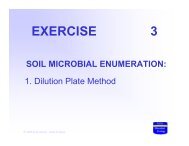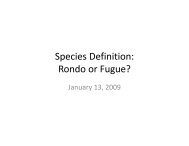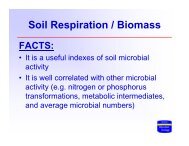Soil Microbial Ecology - Soil Molecular Ecology Laboratory
Soil Microbial Ecology - Soil Molecular Ecology Laboratory
Soil Microbial Ecology - Soil Molecular Ecology Laboratory
You also want an ePaper? Increase the reach of your titles
YUMPU automatically turns print PDFs into web optimized ePapers that Google loves.
Page 52<br />
When a portion of the soil is fumigated (or otherwise sterilized - e.g. microwave<br />
irradiation), the difference in CO 2 evolved between fumigated and nonfumigated soil can<br />
be used to estimate microbial biomass.<br />
The exercise, which follows, will introduce a simple titrimetric method for measuring<br />
C0 2 evolution from soils, and demonstrates the effects that different carbonaceous<br />
substrates have on the rate of C0 2 evolution (microbial respiration). In addition,<br />
comparisons between the fumigated and nonfumigated samples will provide data for<br />
estimating the microbial biomass of the original soil.<br />
MATERIALS:<br />
FIRST PERIOD<br />
<strong>Soil</strong> samples sieved through a 2 mm sieve<br />
Biometer vessel<br />
Solution of NH 4 N0 3 where 2 ml = 12 mg<br />
Glucose<br />
Cellulose powder<br />
NaOH (1N)<br />
Balances<br />
SUBSEQUENT PERIODS<br />
HCl, 1.0 N (132.25 ml conc. HCl in 1 L distilled water), to standardize titrate with 1<br />
ml of phenolphthalein as the indicator, against ca. 1.5 g THAM buffer in 25 ml<br />
distilled water. One mole of THAM = one mole of HCl.<br />
BaCl 2 , 50% solution<br />
Phenolphthalein (1 g phenolphthalein in 100 ml of 95% ETOH)<br />
Pasteur pipettes<br />
Burettes





